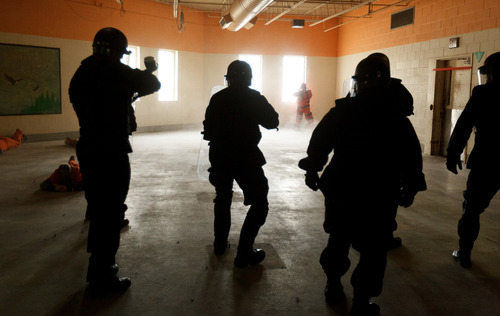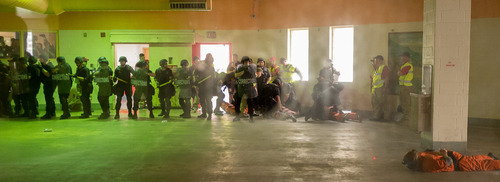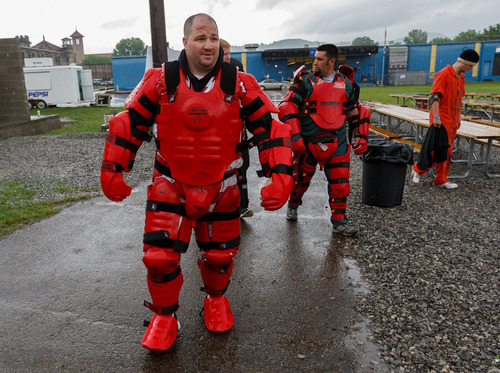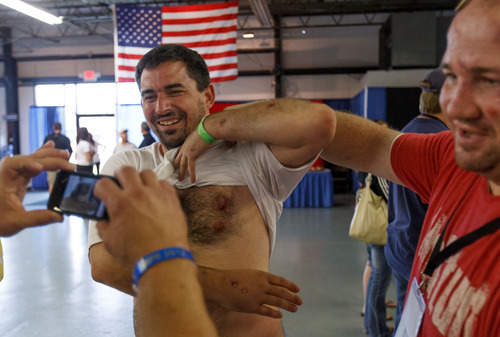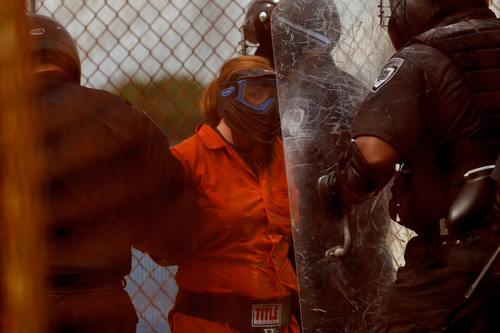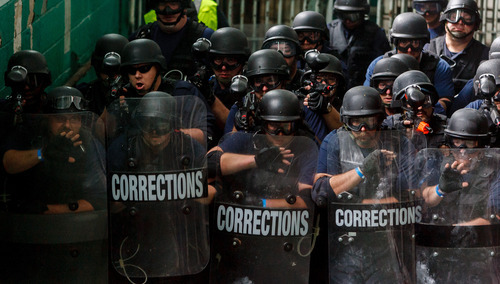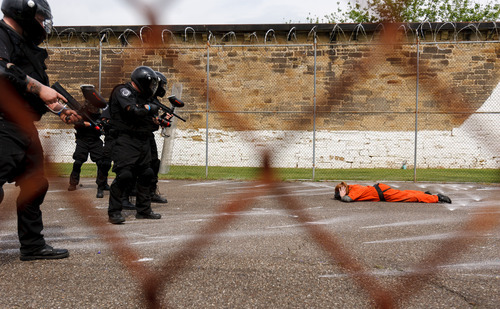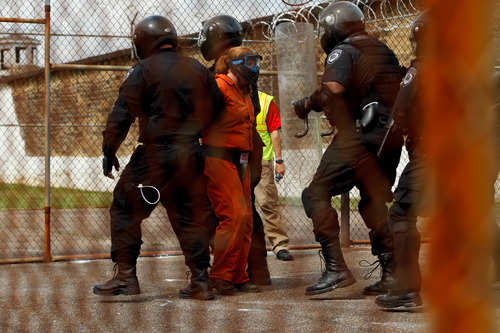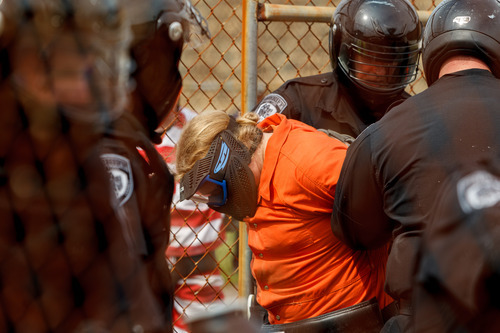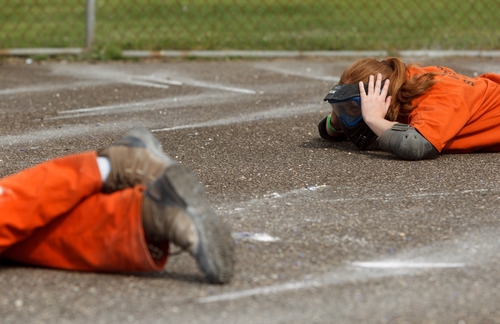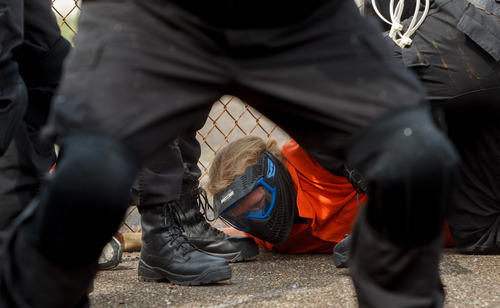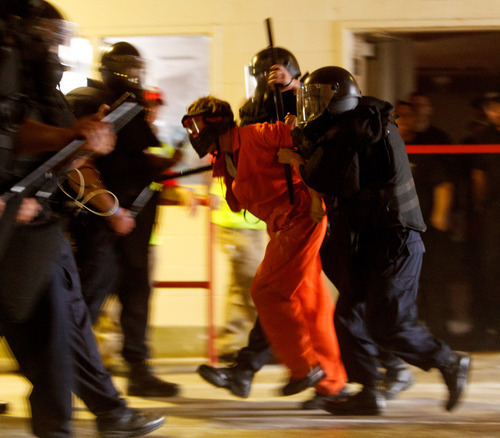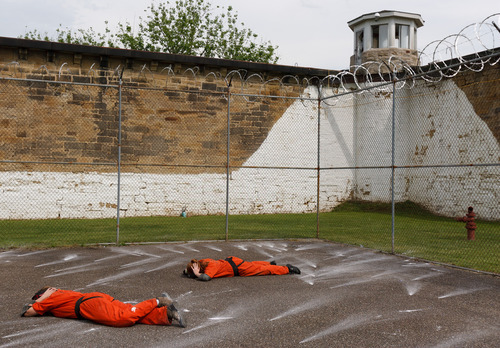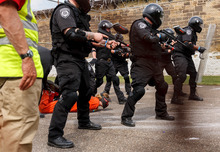This is an archived article that was published on sltrib.com in 2012, and information in the article may be outdated. It is provided only for personal research purposes and may not be reprinted.
Moundsville, W. Va. • A Corrections officer in Weber County for 11 years, Adam Strader has never known what it's like to be an inmate.
Until now.
Standing in his red-and-white stripes, the stocky Strader defiantly refuses the special operations team's shouted instructions to get down on the floor. When the helmeted and armed team swoops in, a roaring Strader rushes into an acrylic shield, avoiding a barrage from a pepper gun.
Strader and a dozen of his classmates from Weber State University dressed as inmates play out this scenario, or a variation of it, nearly 25 times in three days at the 16th annual Mock Prison Riot.
By the end, the 35-year-old is covered in scratches, bruises and welts. The marks win the admiration of his "foes," corrections and jail special-operations teams from throughout the United States and eight countries, who come to practice riot-quelling skills on role players such as Strader and his fellow students.
"You all deserve more than three [school] credits. Mercy!" Robert Brooks, a member of the emergency response team at the Delaware County, Indiana, sheriff's office, tells the roughed-up Strader.
Two days earlier, Brooks' team pelted WSU students, including Rachel Taylor, a 31-year-old mother of six, with small baby-powder-filled balls during a mock riot in the dining hall. Though the balls lack the pepper used in a real emergency, they pack a wallop and leave Taylor with baseball-sized black and blue welts.
Midway through three days of role-playing, after she has been cuffed and dragged probably 18 times, the forensic science and chemistry major is beaming. "This is the best vacation I've ever been on."
Ronnie Williams, the safety officer for the West Virginia Division of Corrections' mock riot, jokes with WSU professor Bruce Bayley about his students' bold performances. "Next year, bring some real players."
—
Grim training ground • Taking part in the annual mock riot has become something of a tradition among WSU criminal justice students.
Bayley, a former county Corrections officer in California, first brought students five years ago; the five-day trip counts for three undergraduate or graduate criminal justice credits. His colleague, forensics professor Brent Horn, has joined in for two years now.
Earlier this month, 16 WSU students and a Weber State-bound high school senior participated in the mock riot at what was once one of the most violent prisons in the country, a gothic edifice in Moundsville, a small city in the West Virginia Panhandle.
The West Virginia Penitentiary operated from 1866 to 1995, but closed when a judge ruled it was cruel and unusual punishment, says Williams. He remembers his first day as a guard here: July 5, 1994. It was 114 degrees inside the prison. "There would be ice on the floor in winter. It was nasty — rats, cockroaches."
Ninety-four inmates were executed here, most by hanging, and another 904 died of various causes over the decades. Charles Manson was here in the early 1980s at his own request; he wanted to be near family.
Prisoners rioted a number of times, including in 1986 when inmates killed three of their own during a 53-hour siege with hostages.
Built with 240 cells, the prison had a peak inmate population of 2,700 in 1937. The number of inmates had declined to 600 in 1995, according to a 2004 prison history, Locked In Time, by John William Larner. In recent years, it has hosted ghost hunters and haunted houses.
And, each spring, the Mock Prison Riot.
—
Choose your fight • With its concrete and steel, peeling paint and inmate art still adorning cramped cells, the prison is the perfect setting for scenarios that range over three days.
Each special operations team devises its own scenarios, depending on training needs.
Some involve extracting inmates from cells, and others are in the dining hall, recreation yard, chapel or an old school bus. They last anywhere from 10 to 40 minutes, depending on the resistance of the role players and the strategy of the special ops team.
Eleven members of the Army's 508th Military Police Battalion at Joint Base Lewis/McCord near Tacoma, Wash., enacted a scenario to capture "inmates" who had taken over the infirmary. Capt. Henry Leung said it was no coincidence; the 2009 shooting spree at Fort Hood, in which an Army psychiatrist killed 13, occurred in a medical setting.
This year, team members from federal prisons throughout the country enacted perhaps the largest scenario, which involved unruly inmates in a recreation yard while others rioted in the cell block. An officer was airlifted by helicopter after he was "injured" as a hostage of the inmates.
Over 16 years, the mock riot has earned a reputation as a place that corrections emergency response teams can get realistic training, says Jim Rubenstein, commissioner of West Virginia Division of Corrections. "Not every state has a decommissioned maximum security facility."
—
'The guys really learn' • The biggest benefit for his students, Bayley says, is the chance to gain real-world experience.
"They see and do things in five days that people who work their entire careers in corrections never get to see and do," he says.
The Mock Prison Riot has vendors — 41 this year — showing the latest weapons and tools, and workshops to help correctional officers get certifications to use certain tools, like the PepperBall guns.
"They can network in this little-known world of correctional officers and get the chance to see how it feels to be on the receiving end," says Bayley.
While only 10 or 15 percent of the students will become correctional officers, exposure to the riot helps those who go into law enforcement or the law as well, he says.
"It helps them understand why the officers do what they do," says Bayley. "It gives you real insight into the officers' perspectives and the reality of how volatile these situations can be."
Midway through the mock-riot scenarios, when a special operations team member play-acting as an inmate is rushed to the hospital for a CT scan, Williams tells the role-players to dial back the defiance.
Inmates, he says, "rarely are as committed as you all have been."
"It's getting a little out of hand and it's going to stop," he says. "I don't want to see any more people get hurt."
Strader, who began his college career as a drama major at Southern Utah University in 1994, says, however, that it is important for those acting as inmates not to be too predictable or compliant.
"If the scenario isn't believable, they don't learn," says Strader, who oversees a cell block at the Weber County jail. "When the game goes south, that's when the guys really learn."



